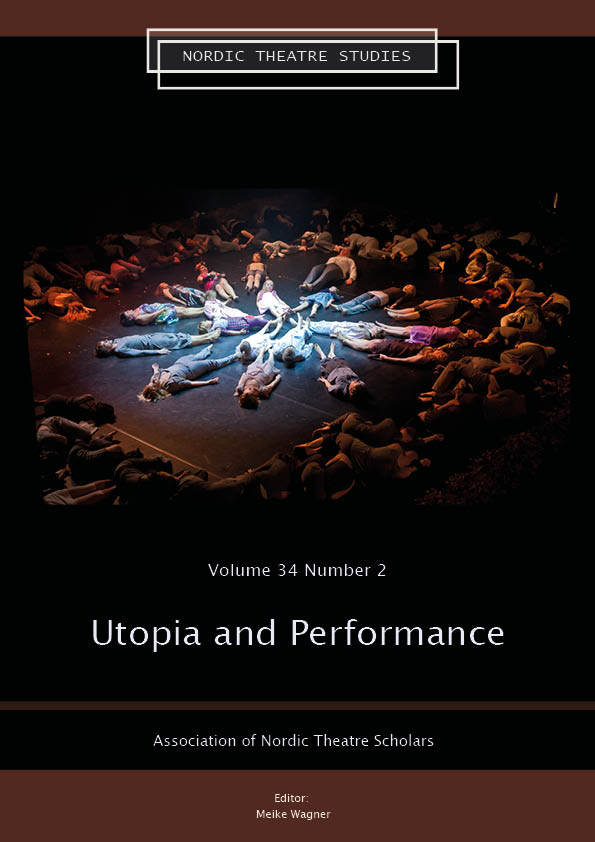When the Utopian Performative Encounters Beauty
DOI:
https://doi.org/10.7146/nts.v34i2.141660Keywords:
utopian performative, aesthetics of the performance, the experience of beauty, dance performance, affect, Oratorium Dance Project, Teatr ChoreaAbstract
I remember the first time I came across the utopian performative: the butterflies in my stomach, the overwhelming feeling of hope and happiness it produced. Jill Dolan [2005] points to those moments during performances when the audience comes together and feels hopeful; moments that constitute inspiration for change: for the performer, the spectator, and maybe even the world – and which are often (understandably) politically or socially charged.
But my experiences were different: my feeling of hope was not emerging after watching a political vision of the future, but during and after my encounters with beauty. I began to wonder: can a profound sense of beauty that brings the feeling of hope and love, also have the potential to change the world?
In this article, I explore the aesthetics of the theatrical event and its effectiveness in bringing out utopian performatives. Theoretically, I draw on Erika Fischer-Lichte’s aesthetics of the performative to show how the language of performance analysis can access a theatrical (aesthetic) experience and on the theory of affect in performance to understand my experience; also, I supplement Dolan’s theory with Dorthe Jørgensen’s experience of beauty to extend her thinking into non-political experiences and grasping them more fully.
As an example, I discuss Oratorium Dance Project (Lodz 2011).
References
Bausch, Pina. 2007. “What moves me”, speech on the occasion of the Kyoto Prize award ceremony. http://www.pinabausch.org/en/pina/what-moves-me (1.6.2023).
Bennett, Jill. 2005. Empathic Vision: Affect, Trauma, and Contemporary Art. Stanford: Stanford University Press.
Clough, Patricia Ticineto. 2007. “Introduction.” In Patricia Ticineto Clough & Jean Halley (eds). The Affective Turn: Theorizing the Social. Durham and London: Duke University Press.
Chorea webpage. Oratorium Dance Project. https://www.chorea.com.pl/pl/projekty/oratorium-dance-project/ (1.6.2023).
Dolan, Jill. 2005. Utopia in Performance. Finding Hope at the Theater. Ann Arbor, Michigan: University of Michigan Press.
Fischer-Lichte, Erika. 2008. The Transformative Power of Performance. A New Aesthetics. London and New York, NY: Routledge.
Jørgensen, Dorthe. 2021. Imaginative Moods: Aesthetics, Religion, Philosophy. Aarhus: Aarhus University Press.
Kozowicz, Alexandra. 2011. “Oratorium Dance Project - amatorzy uczą zawodowców... pasji.” E-teatr.pl 13 December 2011. https://e-teatr.pl/amatorzy-ucza-zawodowcow-pasji-a126998 (1.6.2023)
Lyotard, Jean-François. 1976. “The Tooth, the Palm.” SubStance 5:15, 105-110.
Reason, Matthew. 2017. “Affect and Experience.” In Matthew Reason & Anja Mølle Lindelof (eds). Experiencing Liveness in Contemporary Performance. Interdisciplinary Perspectives. London and New York, NY: Routledge
Sedgwick, Eve Kosofski. 2003. Touching Feeling: Affect, Pedagogy, Performativity. Durham and London: Duke University Press.
Skjoldager-Nielsen, Kim. 2018. Over the Threshold, Into the World. Experiences of Transcendence in the Context of Staged Events. Stockholm: STUTS.
Reason, Matthew and Anja Mølle Lindelof (eds.). 2017. Experiencing Liveness in Contemporary Performance. Interdisciplinary Perspectives. London and New York, NY: Routledge.
Rosa, Hartmut. 2015. Social Acceleration. A New Theory of Modernity. Translated by Jonathan Trejo-Mathys. New York, NY: Columbia University Press.
Skjoldager-Nielsen, Daria. 2021. “Theatre Talks: How to Accommodate Hygge in Theatre Experience.” Nordic Theatre Studies 33:2, 58–71. https://doi.org/10.7146/nts.v33i2.132872.
Skjoldager-Nielsen, Kim and Daria Skjoldager-Nielsen. 2020. “Para-Anthropo(s)cene Aesthetics Between Despair and Beauty: A Matter of Response-Ability.” Nordic Theatre Studies 32:1, 44–65. https://doi.org/10.7146/nts.v32i1.120407.
Thompson, James. 2009. Performance Affects: Applied Theatre and the End of Effect, London and New York, NY: Palgrave Macmillan.
Downloads
Published
How to Cite
Issue
Section
License
The copyright belongs to the authors and Nordic Theatre Studies. Users can use, reuse and build upon the material published in the journal but only for non-commercial purposes. Users are allowed to link to the files, download the files, distribute the files on a local network (preferably by links), upload the files to local repositories if their institutions require them to do so, but not republish the files without proper agreements with the journal and the author.

